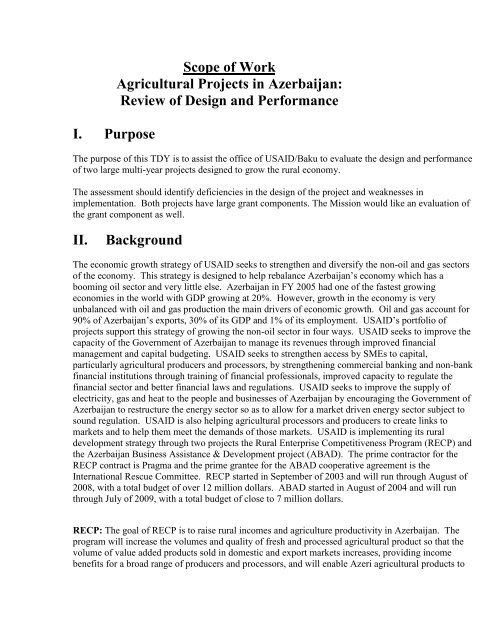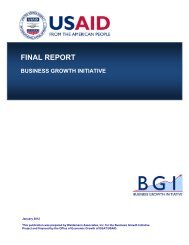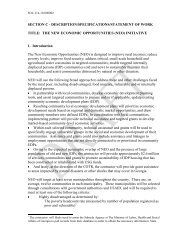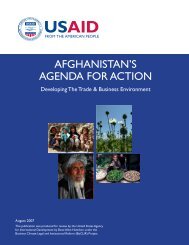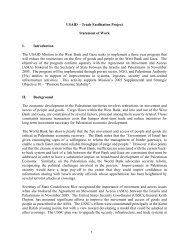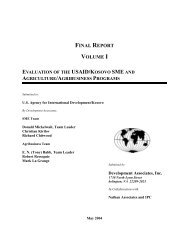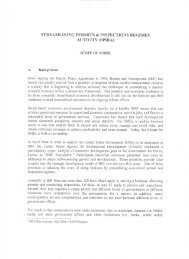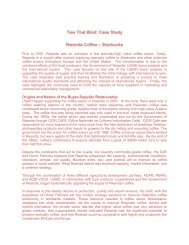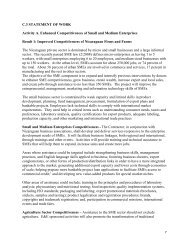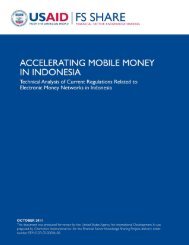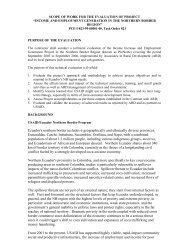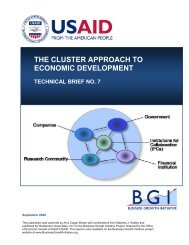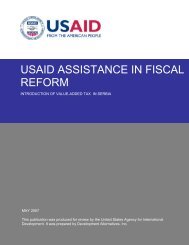Scope of Work - Economic Growth - usaid
Scope of Work - Economic Growth - usaid
Scope of Work - Economic Growth - usaid
Create successful ePaper yourself
Turn your PDF publications into a flip-book with our unique Google optimized e-Paper software.
I. Purpose<br />
<strong>Scope</strong> <strong>of</strong> <strong>Work</strong><br />
Agricultural Projects in Azerbaijan:<br />
Review <strong>of</strong> Design and Performance<br />
The purpose <strong>of</strong> this TDY is to assist the <strong>of</strong>fice <strong>of</strong> USAID/Baku to evaluate the design and performance<br />
<strong>of</strong> two large multi-year projects designed to grow the rural economy.<br />
The assessment should identify deficiencies in the design <strong>of</strong> the project and weaknesses in<br />
implementation. Both projects have large grant components. The Mission would like an evaluation <strong>of</strong><br />
the grant component as well.<br />
II.<br />
Background<br />
The economic growth strategy <strong>of</strong> USAID seeks to strengthen and diversify the non-oil and gas sectors<br />
<strong>of</strong> the economy. This strategy is designed to help rebalance Azerbaijan’s economy which has a<br />
booming oil sector and very little else. Azerbaijan in FY 2005 had one <strong>of</strong> the fastest growing<br />
economies in the world with GDP growing at 20%. However, growth in the economy is very<br />
unbalanced with oil and gas production the main drivers <strong>of</strong> economic growth. Oil and gas account for<br />
90% <strong>of</strong> Azerbaijan’s exports, 30% <strong>of</strong> its GDP and 1% <strong>of</strong> its employment. USAID’s portfolio <strong>of</strong><br />
projects support this strategy <strong>of</strong> growing the non-oil sector in four ways. USAID seeks to improve the<br />
capacity <strong>of</strong> the Government <strong>of</strong> Azerbaijan to manage its revenues through improved financial<br />
management and capital budgeting. USAID seeks to strengthen access by SMEs to capital,<br />
particularly agricultural producers and processors, by strengthening commercial banking and non-bank<br />
financial institutions through training <strong>of</strong> financial pr<strong>of</strong>essionals, improved capacity to regulate the<br />
financial sector and better financial laws and regulations. USAID seeks to improve the supply <strong>of</strong><br />
electricity, gas and heat to the people and businesses <strong>of</strong> Azerbaijan by encouraging the Government <strong>of</strong><br />
Azerbaijan to restructure the energy sector so as to allow for a market driven energy sector subject to<br />
sound regulation. USAID is also helping agricultural processors and producers to create links to<br />
markets and to help them meet the demands <strong>of</strong> those markets. USAID is implementing its rural<br />
development strategy through two projects the Rural Enterprise Competitiveness Program (RECP) and<br />
the Azerbaijan Business Assistance & Development project (ABAD). The prime contractor for the<br />
RECP contract is Pragma and the prime grantee for the ABAD cooperative agreement is the<br />
International Rescue Committee. RECP started in September <strong>of</strong> 2003 and will run through August <strong>of</strong><br />
2008, with a total budget <strong>of</strong> over 12 million dollars. ABAD started in August <strong>of</strong> 2004 and will run<br />
through July <strong>of</strong> 2009, with a total budget <strong>of</strong> close to 7 million dollars.<br />
RECP: The goal <strong>of</strong> RECP is to raise rural incomes and agriculture productivity in Azerbaijan. The<br />
program will increase the volumes and quality <strong>of</strong> fresh and processed agricultural product so that the<br />
volume <strong>of</strong> value added products sold in domestic and export markets increases, providing income<br />
benefits for a broad range <strong>of</strong> producers and processors, and will enable Azeri agricultural products to
displace imports and reach export markets by introducing the competitiveness paradigm in the<br />
agricultural and agri-business clusters <strong>of</strong> Azerbaijan’s economy.<br />
In order to achieve these objectives, the project will focus on two primary tasks, as envisioned by<br />
USAID:<br />
o RECP Task # 1: Improving domestic product quality; and<br />
o RECP Task # 2: Expanding the focus <strong>of</strong> the agribusiness sector on competitive products.<br />
The RECP project has created a local entity, the Azerbaijan Agribusiness Center (AAC), through<br />
which to implement its activities. This was done to ensure the future provision <strong>of</strong> support activities to<br />
the agricultural sector – the AAC will continue to provide services to the Azerbaijan agribusiness<br />
community on a sustainable basis after the RECP project has ended. 1<br />
The AAC describes its service <strong>of</strong>fering as follows:<br />
Production: High value production (greenhouse, high value horticulture); machinery service<br />
supply; extending market windows through innovation; introduction <strong>of</strong> new products; improving<br />
links to processors; formalization <strong>of</strong> market linkages; and modernization <strong>of</strong> production techniques<br />
and inputs.<br />
Marketing: Market research (domestic & export); market surveys, plans and strategy; market<br />
identification & introduction; competitive product identification; participation in trade shows and<br />
market events; and introduction <strong>of</strong> stable contracts for sustainability.<br />
Processing: Linkages to supply; improvement <strong>of</strong> raw materials; improvement <strong>of</strong> process efficiency<br />
and equipment; food safety & quality, HACCP; packaging; competitiveness compared to imports;<br />
and targeted value addition (e.g., cut chicken, fruit yogurt, baby food, processed nuts, tanning).<br />
Logistics: Collection and distribution centers; terminal wholesale markets; catering and<br />
institutional food supply; airline and cargo company infrastructure; transport and machinery<br />
custom service; and transport standards and pooled transport service supply.<br />
Finance and Credit: bankable deals; agribusiness development foundation; alliances or<br />
partnerships for development; facilitation <strong>of</strong> leasing; trade and contract finance mechanisms; asset<br />
registration; and machinery and facility targeted credit and investment.<br />
The project’s aim is to provide demand driven services, focusing not only on production, but on the<br />
needs <strong>of</strong> the marketplace. All products and services will be designed based not on what the Azeri<br />
agribusiness sector can produce or process but what the customer wants. While these topics will be<br />
detailed in subsequent sections, it is important to note the focus on marketing, market linkages, and<br />
value addition along the chain, in keeping with the demand-driven philosophy that guides all AAC<br />
activities.<br />
The project’s three key goals are to create jobs, attract domestic and foreign investment, and increase<br />
domestic and export sales. The <strong>of</strong>ficial PMP (Performance Monitoring Plan) parameters to measure<br />
project performance are based on these goals and are: increases in value added productivity, number<br />
and value <strong>of</strong> trade deals and sales increases, and value <strong>of</strong> investment into agribusiness.
In Year Two, 10 Account Managers provided services to 48 companies, <strong>of</strong> which 42 are long-term<br />
AAC clients. A detailed SWOT is done in the preliminary stages <strong>of</strong> work with each company and the<br />
Account Manager works with an action team from the client to develop an action plan for the future <strong>of</strong><br />
the company and for the role that AAC will play in that development. In Year Two, this process was<br />
improved and a solid base <strong>of</strong> productive clients was established. The project is now poised to increase<br />
that client base dramatically.<br />
With the help <strong>of</strong> AAC, the clients achieved over $2,326,303 in new trade and invested over<br />
$4,862,750 in plant improvements (these are cumulative figures). Assistance from the AAC is tailored<br />
to meet the needs <strong>of</strong> each client, but general areas <strong>of</strong> emphasis include trade and marketing;<br />
processing; finance and credit; and logistics and inputs. In addition, there have been 804 new jobs<br />
created in AAC client companies. A rough guide used by many organizations to show the impact that<br />
trade and investment has on employment is that for every $10,000 dollars <strong>of</strong> trade/investment, one job<br />
is created. Based on this guide the project’s rate <strong>of</strong> job creation well exceeds what might be expected<br />
from the level <strong>of</strong> trade/investment achieved by clients.<br />
ABAD: ABAD focuses on creating value for Azeri producers and businesses and repairing the supply<br />
chain that remains broken since the collapse <strong>of</strong> the Soviet Union.<br />
During its first year <strong>of</strong> operation ABAD staff completed the competitive bidding process for<br />
Marketing Center operators, provided start-up training to Marketing Center staffs, and guided<br />
Marketing Center management in developing annual operating plans. All eight Marketing Centers in<br />
the four economic corridors are open, staffed and operational. Though work is still in the early stages,<br />
Marketing Centers have already contacted hundreds <strong>of</strong> buyers and sellers and begun working in<br />
earnest with over 50 clients through the development <strong>of</strong> Client Development Plans, laying the<br />
foundation for developing market linkages in the corridors and beyond. Training is underway to<br />
enhance the consulting capacity <strong>of</strong> business advisors, equipping them with necessary tools to identify<br />
value-added opportunities and facilitate deals to generate increases in jobs and sales.<br />
As the Marketing Centers have developed their client bases, the Grants Program has begun receiving a<br />
growing number <strong>of</strong> requests for grant assistance. Of the 25 Client Development Plans thus far<br />
approved by ABAD management, approximately half requested grant assistance, and <strong>of</strong> these, three<br />
grant applications have been developed, submitted and are pending final approval.<br />
An assessment was conducted during the reporting period to evaluate the credit and leasing<br />
environment in Azerbaijan and to develop recommendations that will enable ABAD to increase access<br />
to credit and leasing services in ABAD project areas during Year 2. This included a survey <strong>of</strong> 960<br />
individual entrepreneurs in ABAD’s economic corridors to assess the demand for leasing and other<br />
credit services, and developing an overview <strong>of</strong> the formal-sector leasing services currently available.<br />
This period, ABAD’s monitoring and evaluation (M&E) team fine tuned the M&E approach and<br />
s<strong>of</strong>tware, completed installing the database on computers at all eight Marketing Centers and trained<br />
Marketing Center personnel in its application. The M&E team also updated forms and data fields to<br />
ensure that the data collected addresses program needs.<br />
While start-up activities have succeeded in putting the critical elements <strong>of</strong> the ABAD program in<br />
place, significant challenges remain. Although ABAD selected Marketing Center operators from
among existing organizations with personnel experienced in providing services to rural stakeholders, it<br />
will be necessary to continue to put significant efforts toward training and consulting with Marketing<br />
Center personnel to develop their understanding and ability to apply ABAD’s market-driven approach.<br />
A particular area <strong>of</strong> need for increased capacity development is in preparing grant proposals that fulfill<br />
ABAD’s criteria. Likewise, ABAD anticipates it will need to continue providing significant support<br />
to the Centers in the areas <strong>of</strong> basic <strong>of</strong>fice operation and management.<br />
At the same time, ABAD is taking advantage <strong>of</strong> opportunities to cooperate with partners on a number<br />
<strong>of</strong> complementary efforts in Baku and the economic corridors that bolster and bring additional<br />
resources to the Centers’ efforts to facilitate transactions between the Marketing Centers clients and<br />
the buyers <strong>of</strong> their products. Applying a new model for economic development in Azerbaijan, ABAD<br />
will stimulate over $15 million in sales and create 4,000 jobs by 2009. The added jobs and sales will<br />
invigorate rural economies, serving as a basis for sustained economic growth over the long term.<br />
III<br />
Activity Description<br />
<strong>Scope</strong> <strong>of</strong> work<br />
The TDY team will do a thorough review <strong>of</strong> the RECP and ABAD project design and implementation<br />
resulting in a set <strong>of</strong> recommendations to the Mission. The specific tasks that will be undertaken by the<br />
TDY team to prepare the deliverables <strong>of</strong> the TDY team are:<br />
<br />
<br />
<br />
<br />
<br />
<br />
<br />
<br />
<br />
<br />
<br />
Review the contract for both projects and all project reports<br />
Review work plans for both projects<br />
Review Grant Manuals for each project<br />
Review grant applications from both projects<br />
Review USAID’s IR related to the projects<br />
Meet with the USAID Country Director, Program Officer, EG Acting Team Leader, FSN<br />
Agricultural Specialist<br />
Meet with the projects’ staff<br />
Visit Marketing Centers<br />
Visit Processors and Producers assisted by the projects<br />
Meet USAID supported agricultural lenders<br />
Meet staff <strong>of</strong> USAID SME Financial Strengthening Project<br />
It is anticipated that the Evaluation team will first complete a desk study that will be used<br />
to establish an understanding <strong>of</strong> the agribusiness activities and environment before arrival<br />
in-country. The SO 1.3 team will provide documentation electronically to the Evaluation<br />
team the week prior to their departure in order for the team to prepare.<br />
The work plan should be ready for discussion at the in-brief and adjustments then made<br />
based upon comments by Baku staff at the in-brief. The work plan should include<br />
information that:
1. Explains the methodology for carrying out the evaluation;<br />
2. Identifies potential major constraints; and<br />
3. Presents other information the evaluation team wishes to provide.<br />
We expect that the evaluation will:<br />
1. Compare project design to generally agreed-upon international best practices and<br />
recommend changes.<br />
2. Determine if internal project management problems have jeopardized or damaged or<br />
set back the projects and if so, make recommendations.<br />
3. Address if there is duplication <strong>of</strong> activities, and/or if activities are working in sync or<br />
at odds with each other and recommend remedial actions if needed.<br />
4. Address crosscutting themes. Are they incorporated to a serious extent?<br />
5. Determine if project management is cooperating within SO, across SOs, and with<br />
other donor interventions, and working adequately with the GOAZ.<br />
6. Determine if USAID is adequately addressing and furthering its strategic priority <strong>of</strong><br />
growing the non-oil sectors <strong>of</strong> the economy through RECP and ABAD; and if not<br />
suggest better alternatives.<br />
7. Recommend reading materials on best practices for market chain development and<br />
including best practices on financing ag processing and rural development for the<br />
Baku staff.<br />
8. Comment on the criticism <strong>of</strong> the projects by an outside expert who reviewed USAID’s whole<br />
portfolio and which is copied below.<br />
9. Recommend how sound business proposals can be developed into bankable deals<br />
rather than grant funded.<br />
10. Evaluate impact, if any, <strong>of</strong> grants on efforts to create sustainable rural lenders.<br />
11. Evaluate effectiveness <strong>of</strong> the grant component <strong>of</strong> RECP and ABAD in promoting<br />
sustainable improvements to the rural economy and suggests ways in which the grant<br />
funds could be more effectively deployed, if appropriate.<br />
12. Evaluate administration <strong>of</strong> grant component in RECP and ABAD for vulnerability to<br />
fraud and malfeasance and recommend appropriate changes.<br />
Comments <strong>of</strong> outside expert<br />
The RECP design is curious as best as can be discerned from a rather thin work plan.<br />
RECP emphasizes building value chains for particular commodity groups, a well known<br />
concept in “competitiveness” circles. However, it appears that USAID designed RECP to<br />
work on the supply side <strong>of</strong> commodity value chains while ABAD is designed to work<br />
from processing to marketing. This division <strong>of</strong> labor does not make sense in<br />
competitiveness theory and practice. 2 Normally, agribusiness projects are designed to<br />
cover the whole value chain and that approach usually yields the best results. In this<br />
regard, the work plan mistakenly identifies “transportation, warehousing and logistics” as<br />
“peripheral services” when they are actually integral to value chain and cluster<br />
development. In addition:<br />
2 See, for example, Fairbanks, Michael and Stace Lindsay, Plowing the Sea: Nurturing the Hidden Sources<br />
<strong>of</strong> <strong>Growth</strong> in the Developing World, 1997 or Michael Porter’s seminal The Competitive Advantage <strong>of</strong><br />
Nations, 1990.
It appears that grant making was required in the original USAID solicitation and if so,<br />
and like the ABAD project, that is not a best practice if grants are directed to<br />
<strong>of</strong>fsetting the costs <strong>of</strong> equipment for individual farmers or entrepreneurs.<br />
Under client outreach, it appears BDS is provided with no fee. If so, that is a practice<br />
that should be stopped as it stifles pr<strong>of</strong>essionalism in BDS and business growth.<br />
Other donors, or even other USAID projects, may complain if they have to compete<br />
with free BDS services while they are trying to develop pr<strong>of</strong>itable businesses.<br />
The work plan is explicit that RECP will help clients interact with investors and<br />
financial organizations, presumably MFIs, NBFIs and commercial banks, rather than<br />
provided grants; this is a distinct difference from and improvement over, ABAD.<br />
Azerbaijan Business Assistance and Development Program (ABAD) 3<br />
Overall, this is a large, poorly designed project with ample funding and an extended life<br />
span. If resources were needed elsewhere to advance the fight against corruption,<br />
redesigning this project <strong>of</strong>fers the possibility <strong>of</strong> reprogramming funds to a higher order<br />
purpose. More specifically:<br />
It is rare to see a business development (BDS) project is awarded as a Cooperative<br />
Agreement, especially to a provider that has weak organizational credentials in BDS.<br />
Unless the project was solicited under a RFP, and IRC won in full and open<br />
competition, it is likely that USAID has not acquired the services <strong>of</strong> the most capable<br />
technical assistance provider.<br />
The idea <strong>of</strong> using project funds to establish and operate marketing centers is at least<br />
25 years old and has been discredited for at least the past 10 years, because there are<br />
few if any known success stories, upon the termination <strong>of</strong> donor assistance. This is a<br />
matter <strong>of</strong> project design deviating from well recognized best practices. 4<br />
The project apparently aims to make grants both to marketing centers and to clients<br />
for equipment, machinery and infrastructure. One example, a grant sufficient to<br />
cover 45% <strong>of</strong> a cold storage facility, is troubling because it should have been referred<br />
to the banking system. In another example, ABAD is making a grant to farmer for a<br />
power line to his mill. 5 Best Practices in business development have excluded such<br />
approaches for a long time because they do not lead to enterprise pr<strong>of</strong>itability without<br />
also distorting the market. They may also create the appearance <strong>of</strong> favoritism or,<br />
worse yet, corruption. ABAD should be directing entrepreneurs and the marketing<br />
centers to MFIs, NFBIs or commercial banks.<br />
ABAD is also concerned with developing the leasing industry but no grant funds<br />
should be made available for either the lessor or lessee. The use <strong>of</strong> appropriated<br />
monies to establish a Rural Leasing Guarantee Fund is equally problematic and better<br />
3 International Rescue Committee, Azerbaijan Business Assistance and Development (ABAD) <strong>Work</strong> Plan:<br />
Year 2, August 5, 2005 through August 4, 2006.<br />
4 See the following compendium <strong>of</strong> best practices: Ernst, Ulrich, Marina Krivoshlykova, Donald Snodgrass,<br />
James Packard Winkler, Enterprise <strong>Growth</strong> Initiatives: Strategic Directions and Options – Handbook,<br />
Development Alternatives, Inc., for the Bureau <strong>of</strong> <strong>Economic</strong> <strong>Growth</strong>, Agriculture and Trade, USAID,<br />
Washington D.C. July 2004<br />
5 International Rescue Committee, Azerbaijan Business Assistance and Development (ABAD), Semi Annual<br />
Report, February 5-August 4, 2005.
left to the banking system and to the financial viability <strong>of</strong> the entrepreneurs’<br />
proposals.<br />
The activity on women and entrepreneurship appears to be empty <strong>of</strong> content.<br />
The activity on community support for marketing centers is better left to s<strong>of</strong>t projects<br />
like the Community Development project or abandoned all together.<br />
The activity on marketing center monitoring and evaluation is an effort to create MIS<br />
capacity that will not likely survive the end <strong>of</strong> USAID funding.<br />
There is no mention <strong>of</strong> anti-corruption in the work plan. In the semi-annual report<br />
there is perfunctory mention <strong>of</strong> other related USAID projects, i.e. RECP, ABA-<br />
CEELI and Community Development but no tangible evidence <strong>of</strong> coordination.<br />
III. Staffing and level <strong>of</strong> effort<br />
The design and implementation review will be conducted by one USAID employed<br />
business development expert, Mr. Stephen Silcox, and one agricultural expert contractor,<br />
preferably with experience in the FSU. The TDY team will be accompanied by the<br />
Mission’s FSN agriculture specialist. The Mission will schedule the meetings and<br />
provide work space and a computer at the Mission <strong>of</strong>fice for Mr. Silcox when needed.<br />
The contractor will be responsible for his own logistical support including, hiring an<br />
interpreter and providing in-country transportation for the team. Mr. Silcox will have<br />
ultimate responsibility for the deliverables. He will supervise and direct the work <strong>of</strong> the<br />
agricultural specialist contractor.<br />
IV. Delivery Schedule<br />
The contractor will have 2 work days to complete the desk study prior to departure and 3<br />
work days to participate in the drafting <strong>of</strong> the report after departure from Azerbaijan. The<br />
team is anticipated to be in country for 2 full work weeks in late February and early<br />
March. The contractor will be allowed a 6 day workweek.<br />
V. Deliverables<br />
In brief, midbrief and outbrief will be scheduled with Mission staff in Baku. The TDY<br />
team will provide a draft report including background, conclusions and recommendations<br />
at the outbrief. The contractor agricultural specialist will provide a draft evaluation report<br />
to Mr. Silcox entitled “Draft Evaluation Report on USAID/Azerbaijan’s Agricultural<br />
Projects’ the day prior to the outbrief. The report will address in detail the 12 expected<br />
outcomes <strong>of</strong> the evaluation listed above, with recommendations that identify new<br />
activities or orientations, for mission comment and will be limited to thirty pages (plus<br />
annexes).” Then, the mission will have 10 days to respond. The contractor will have 5<br />
working days to respond to the Mission’s comments and will provide editorial review <strong>of</strong><br />
at least 2 drafts <strong>of</strong> the consolidated Evaluation Report that will be finalized by Mr.<br />
Silcox. The contractor will provide editorial review within 2 working days <strong>of</strong> receipt <strong>of</strong> a<br />
draft report from Mr. Silcox.


